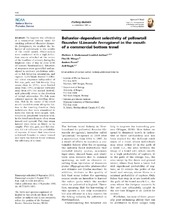| dc.contributor.author | Underwood, Melanie | |
| dc.contributor.author | Winger, Paul D. | |
| dc.contributor.author | Fernø, Anders | |
| dc.contributor.author | Engås, Arill | |
| dc.date.accessioned | 2016-06-06T12:31:19Z | |
| dc.date.available | 2016-06-06T12:31:19Z | |
| dc.date.issued | 2015-09-02 | |
| dc.Published | Fishery Bulletin 2015, 113(4):430-441 | eng |
| dc.identifier.issn | 0090-0656 | en_US |
| dc.identifier.uri | http://hdl.handle.net/1956/12069 | |
| dc.description.abstract | To improve the efficiency of a commercial bottom trawl for catching yellowtail flounder (Limanda ferruginea), we studied the behavior of individuals in the middle of the trawl mouth. Observations were conducted with a high-definition camera attached at the center of the headline of a trawl, during the brightest time of day in June 2010 off eastern Newfoundland. Behavioral responses were quantified and analyzed to evaluate predictions related to fish behavior, orientation, and capture. Individuals showed 3 different initial responses independent of fish size, gait, and fish density: they swam close to (75%), were herded away from (19%), or moved vertically away from (6%) the seabed. Individuals primarily swam in the direction of initial orientation. No fish were oriented against the trawling direction. Fish in the center of the trawl mouth tended to swim along the bottom in the trawling direction. Only individuals that were stimulated to leave the bottom were caught. Individuals in peripheral locations within the trawl mouth more often swam inward and upward. Fish that swam inward were twice as likely to be caught. Fish size, gait, and fish density did not influence the probability of capture. A trawl that stimulates yellowtail flounder to orient inward and leave the bottom would increase the efficiency of a trawl. | en_US |
| dc.language.iso | eng | eng |
| dc.publisher | NOAA | en_US |
| dc.relation.uri | http://fishbull.noaa.gov/1134/underwood.pdf | |
| dc.rights | Attribution CC BY 3.0 NO | eng |
| dc.rights.uri | http://creativecommons.org/licenses/by/3.0/no/ | eng |
| dc.title | Behavior-dependent selectivity of yellowtail flounder (Limanda ferruginea) in the mouth of a commercial bottom trawl | en_US |
| dc.type | Peer reviewed | |
| dc.type | Journal article | |
| dc.date.updated | 2016-04-07T08:23:01Z | |
| dc.description.version | publishedVersion | en_US |
| dc.identifier.doi | https://doi.org/10.7755/fb.113.6 | |
| dc.identifier.cristin | 1292056 | |
| dc.relation.project | Norges forskningsråd: 203477 | |
| dc.subject.nsi | VDP::Matematikk og Naturvitenskap: 400 | en_US |

